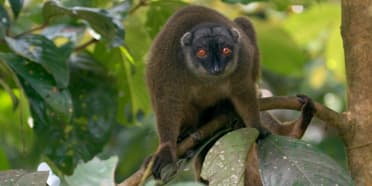Nosy Mangabe Special Reserve (Réserve Spéciale de Nosy Mangabe) is part of Masoala National Park and an idyllic wildlife destination. It includes Nosy Mangabe, the largest island in Antongil Bay, which was once a refuge for pirates and slave traders. Today the reserve is known for its lemurs, reptiles and fine scenery. It is also a breeding site for several thousand humpback whales from July to September.
Best Time To Go
August to November (Less rain)
High Season
July, August and December holidays (Though it doesn’t get busy)
Altitude
0-332m / 0-1,089ft
Pros & Cons
- Adventurous off-the-beaten-track destination
- Primary forests surrounded by tropical seas
- Exciting hiking and kayaking opportunities
- Accessible by chartered boat or on foot only
- Tropical climate makes access difficult for much of the year
Nosy Mangabe SR Safari Reviews
- Wildlife
- Scenery
- Bush Vibe
- Birding
- Wildlife
- Scenery
- Bush Vibe
- Birding
Wildlife
The island is famous for its population of introduced aye-aye, but these weird-looking lemurs are rarely seen since they are only active at night and night walks are no longer allowed. Two other introduced species that you’re more likely to see are the black-and-white ruffed lemur and white-fronted brown lemur. The tropical island is also a refuge for lots of chameleons, frogs, leaf-tailed geckos and snakes, including the Madagascar tree boa.
Scenery
Nosy Mangabe is an unspoiled island paradise. The special reserve covers the whole island, and there is very little tourism development. There are several well-maintained trails, including one to the summit, but otherwise this is pristine nature at its best. Sandy beaches are fringed by dense rainforest, the canopy of which protects the island and its inhabitants from the tropical sun.
Activities
Hiking and kayaking are the main activities on Nosy Mangabe. Walking trails are limited by the size of the island, but the dense forest, views of the turquoise sea, and the chance to see lemurs and chameleons makes for highly enjoyable hikes.
Weather & Climate
Nosy Mangabe’s tropical climate is wet and humid, with a drier period from August to November. At this time, the average daytime temperature is 26°C/79°F, while nights cool down to around 17°C/63°F. The rest of the year is hot, with an average daytime temperature of about 28°C/82°F. February to March is the main cyclone season (although they can appear as early as January), and visiting during these months is not recommended.
Best Time To Visit
Rainfall is high throughout the year, but the drier period from August to November offers the best hiking conditions. From July to the end of September is a special time: it’s when humpback whales come to Antongil Bay to have their young. Nosy Mangabe is also known for its large numbers of amphibians and reptiles, and they are most active from September to February.
Want To Visit Nosy Mangabe SR?
Nosy Mangabe Tours
Nosy Mangabe SR Safari Reviews


